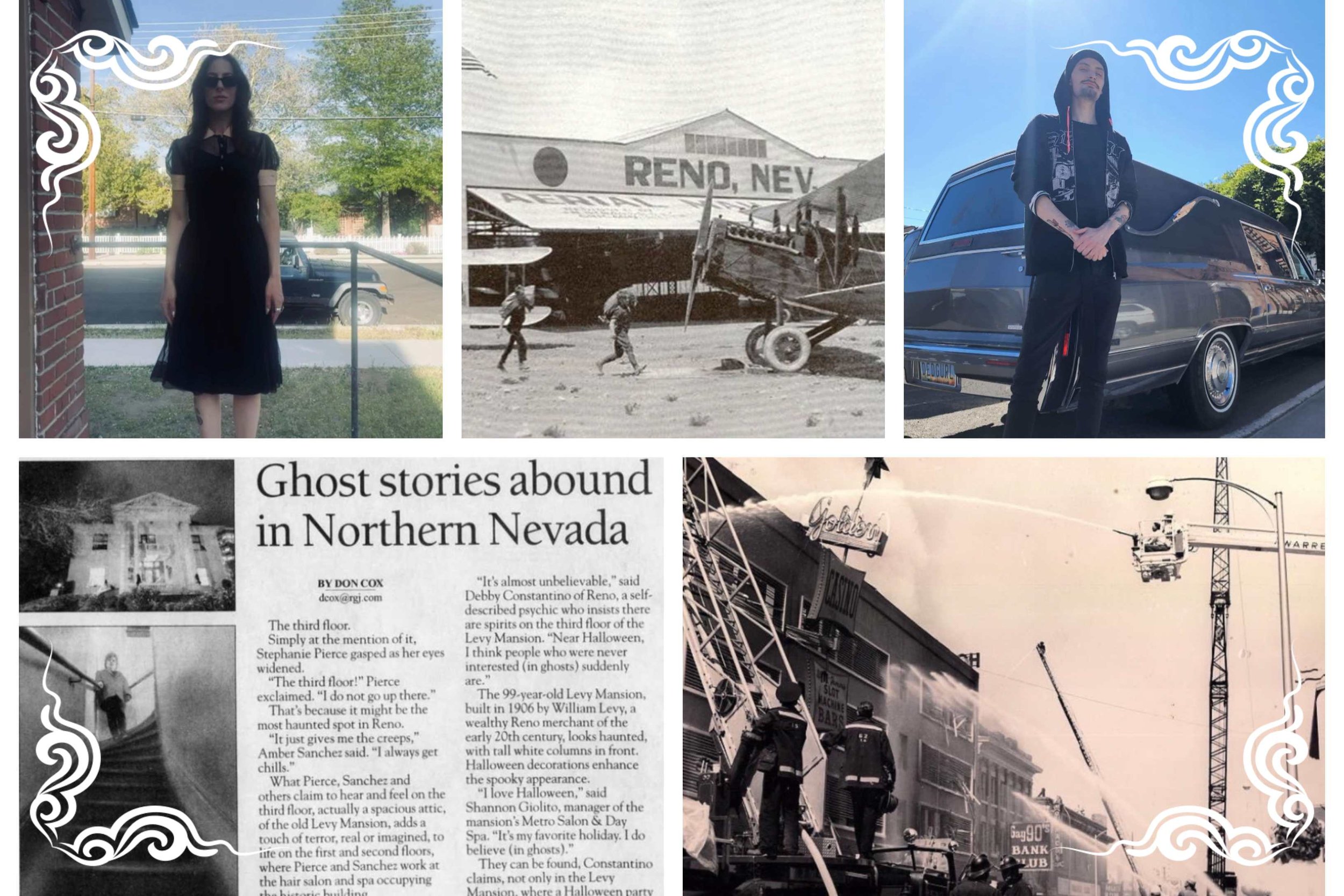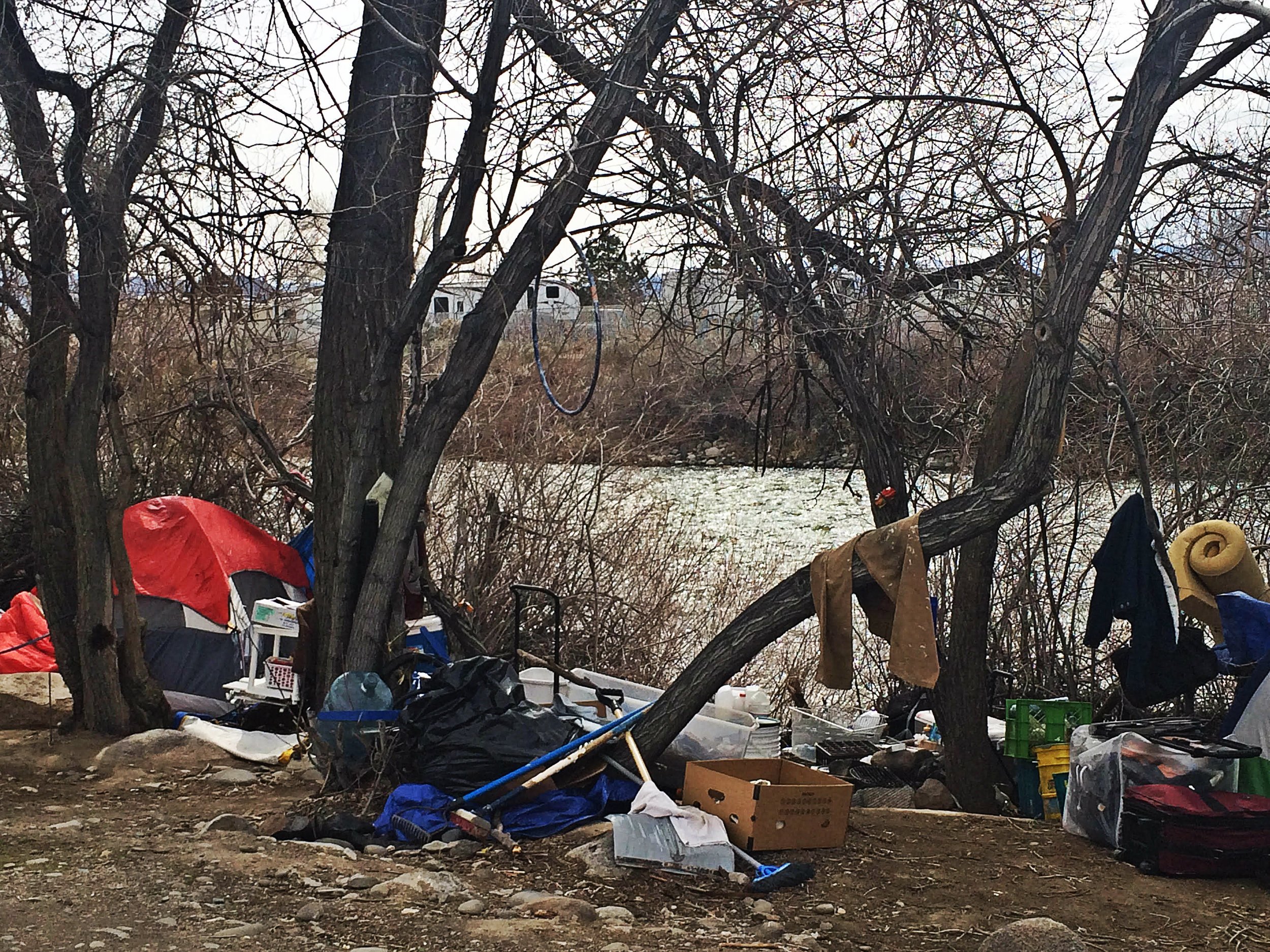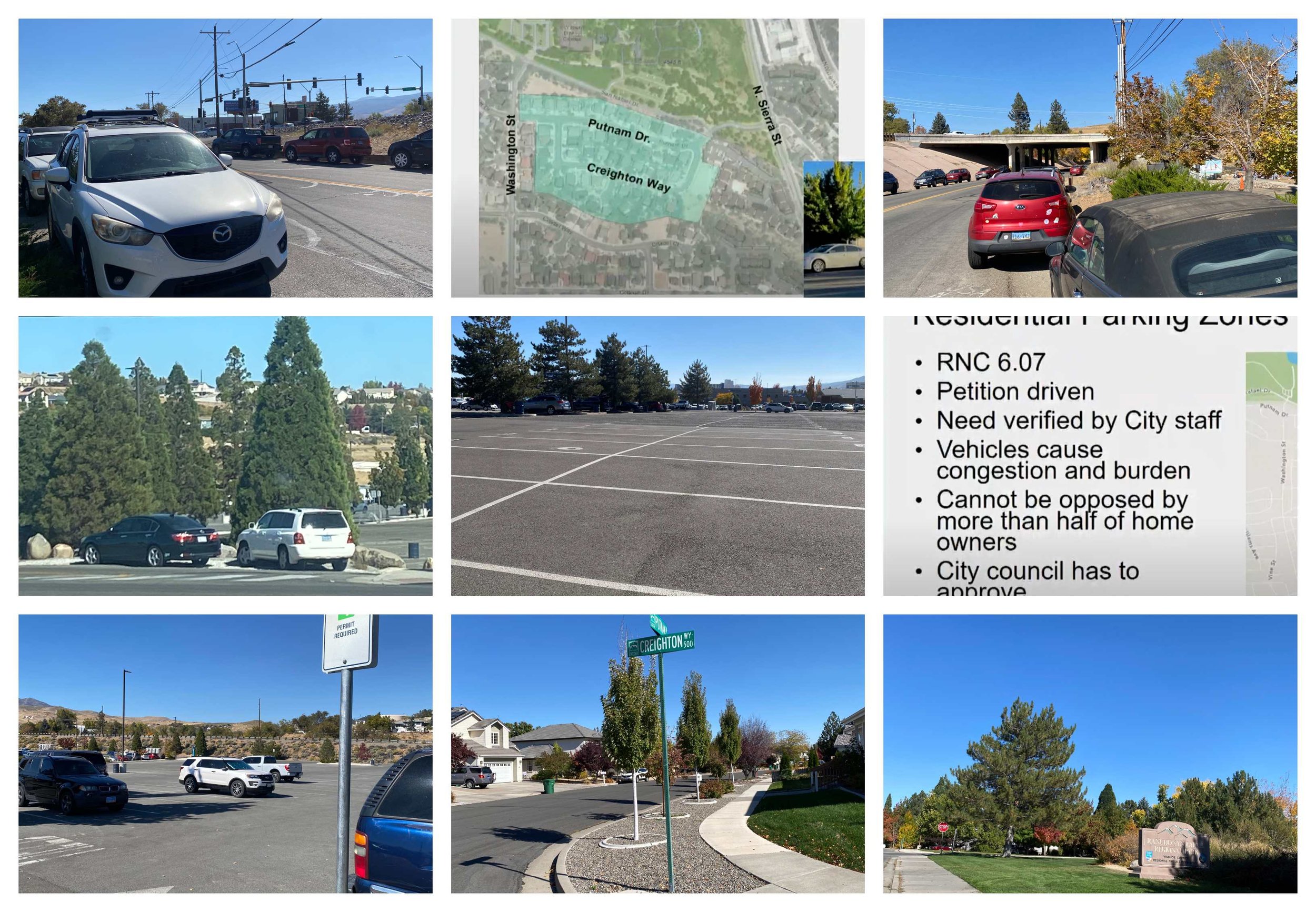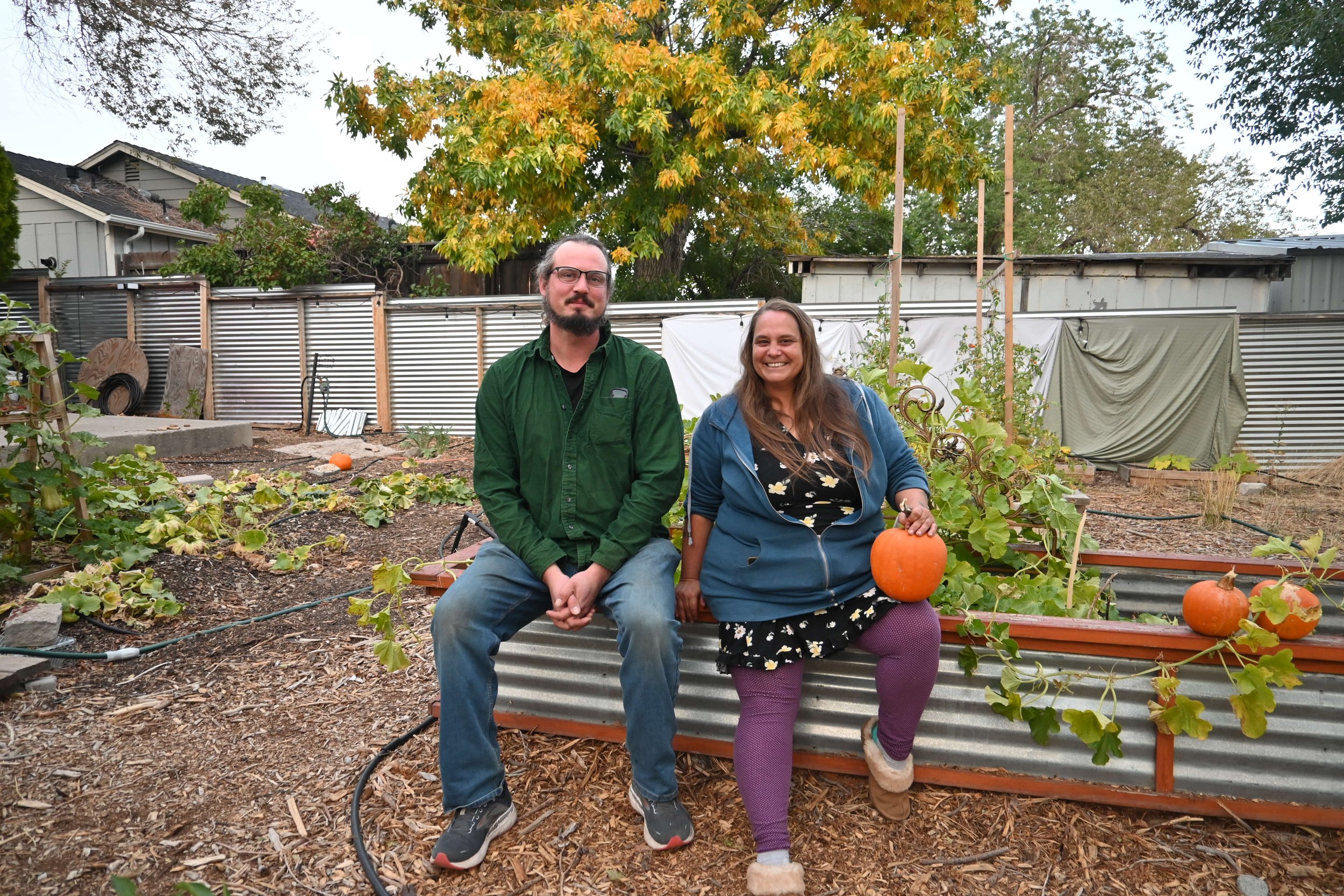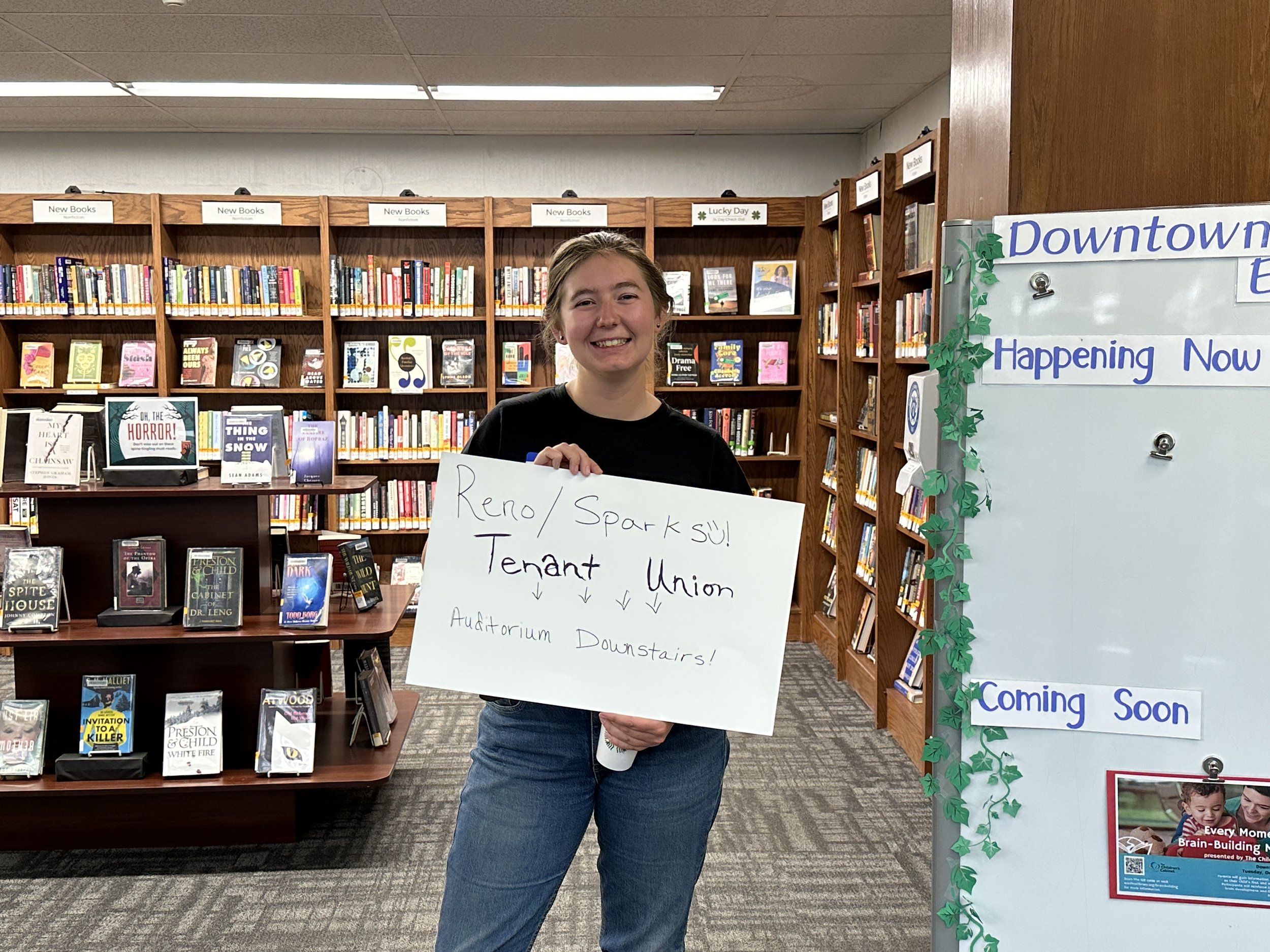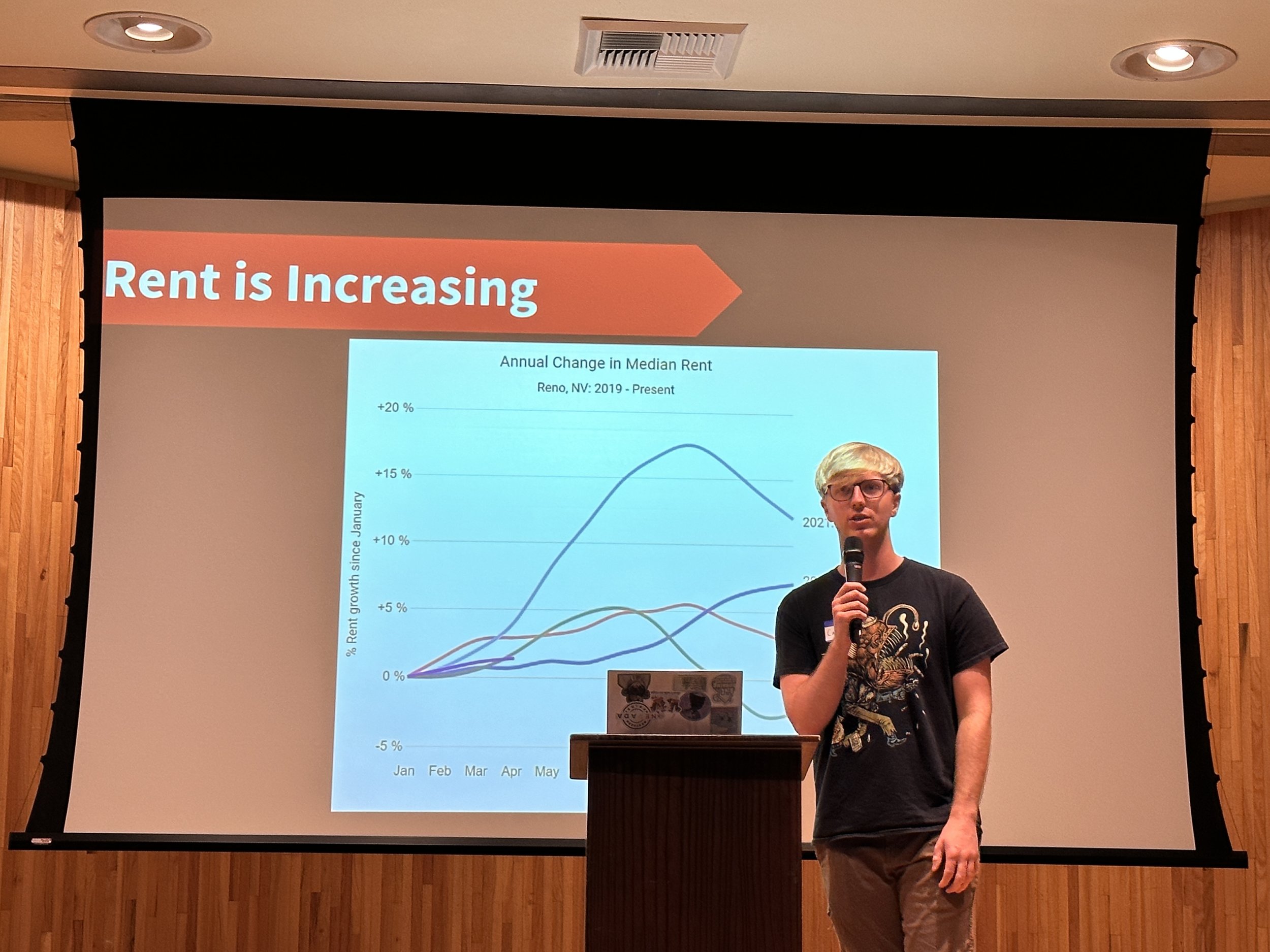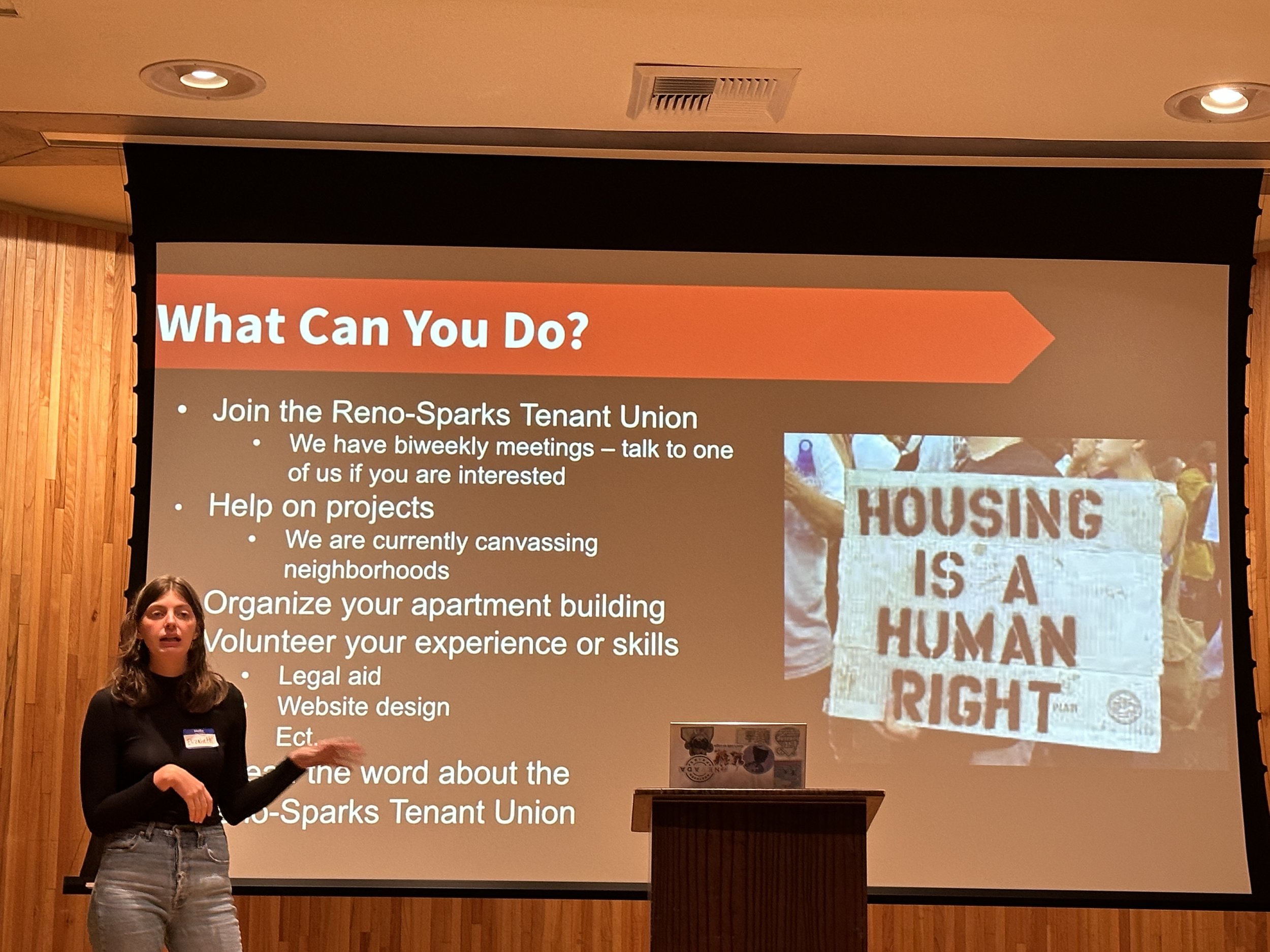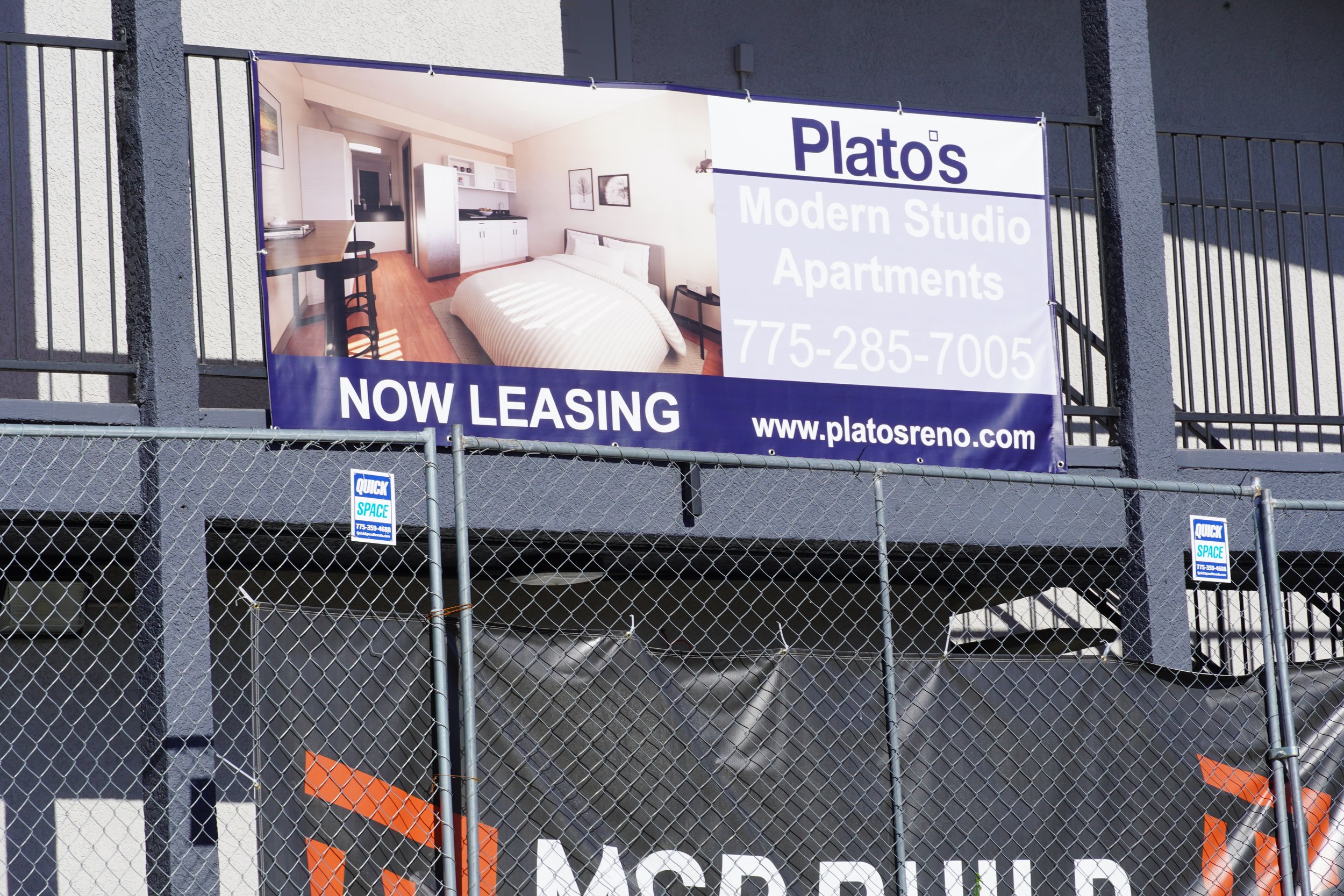Erin and Nik with Reno Ghost Tours host haunted walking tours of downtown, sharing with both locals and tourists their knowledge of nearby haunts and alleged paranormal activity, while giving insight into the rich history of Reno. They have recently expanded and now offer a Midtown ghost tour on top of their already popular Downtown Reno ghost tour. Reporter Gaia Osborne sat down with Nik and Erik to discuss the origins of Reno Ghost Tours, and all things haunted Nevada.
Can you tell me a little bit about your background and how the idea for Reno Ghost Tours first came about?
Erin: My name is Erin. I’ve lived in Reno since 2020, although I moved to Seattle for a little bit in 2021. I currently have three jobs, I’m the operations manager at Tahoe Trail Bar. I’m also a web developer and co-owner of Reno Ghost Tours.
Nik: I’m Nik! Even though I don’t exactly have a defined role, I sort of co-started Reno Ghost Tours with Erin, and I am a tour guide. I’m 27 and was born and raised in Reno, so I’d say for about 20 years, I’ve been learning about Nevada history. I was also a paranormal investigator for about seven years. Currently I just work as a barista at my brother’s coffee shop called Forged which is downtown and inside The Jesse, so I’m pretty much in the epicenter of a good amount of history.
Erin: I’ve been a tour guide for six years, all starting when I lived in Savannah, Georgia. When I moved to Seattle, Washington, I did some ghost tours there too. Then I moved here, and noticed that we didn’t have any ghost tours in Reno. I knew of one other, which was started by Janice Oberding, a local author who has written most of the haunted books in the area. She gave ghost tours for years, and I saw that she stopped giving them around three years ago. It kind of got swept away, so somebody had to step in. So I started doing a lot of research on the history of Reno, and found out that Nik was a ghost hunter and already knew lots about the history of the area. I approached Nik and asked if he wanted to join me. We created a script and did a lot of history research together, and that’s how it started. Our first tour was in October 2021. We only give tours on weekends, so I think we ran like three or four tours total. But they were pretty successful. We went forward with the idea that we wanted to do more, so we did lots of planning and preparation for pretty much that whole year so that this year, we were able to get started much sooner.
You both do a lot of urban exploration and historical research on places here in Reno. Have you ventured outside of Reno, further out into rural Nevada for some of your adventures?
Nik: Yeah, as I mentioned I was a paranormal investigator. I happened upon this with just a really fun, kind of stupid idea. Together with some former associates, we had the idea to get together and start going into abandoned locations. We looked up mostly outdoor locations, a lot of historical places. The first one I ever visited myself was the Donner Pass train tunnels up in Truckee. I basically took it upon myself to be the research person and semi-historian and look up some lore, find some ghost stories, things like that about Donner Pass. Afterwards, I did a lot of exploring around Gardnerville and Carson. There’s a couple of really cool, tiny little towns outside there and the surrounding areas. From there, I branched out a little bit further into California and then basically stayed around that area for a couple years, hitting a whole bunch of little towns there and then also seeing everything there is to see in Virginia City as well. So I had a little bit of experience, not a super wide area, but I definitely have explored a lot throughout Nevada and California.
How do you approach exploring more rural, hard-to-reach abandoned sites compared with the easier-to-access old buildings and locations here in Reno? What kind of safety and precautionary measures do you have to consider?
Nik: First and foremost, there’s definitely an extreme sense of foreboding and anxiety involved because you don’t really know what you’re going to be walking into. Whether it’s a living ghost town (which is where not many people live there), or it’s a legitimate ghost town (with abandoned buildings and nobody living there). There’s definitely a sense of ‘I’m all alone out here,’ so either I have to be watchful for animals, or I just have this place to myself to explore, which is a really cool feeling. Taking that and translating that to a building in Reno, whether it’s an occupied business or an abandoned house, there’s always a feeling that it’s a little bit safer, because at least you know you’re probably within a square mile of somebody else. But safety is a big concern. When you really get into the world of urbex, or urban exploration, you have to take into account how old the buildings and sites are, whether it's sturdy or not, whether your foot might fall through a board. You have to be very careful of your footing, and check whether there are any hoes in the ground, or dangerous equipment or nails nearby. Anything like that. It’s best to wear standard hiking gear, sturdy boots (something with fixed soles). You have to account for weather changes, so a jacket or hoodie, and a hat. Possibly something even stronger for your head in case something falls on you. And definitely a flashlight, because you have no idea how dark a place is that you’re going to be going into.
What does your research and tour preparation look like? How do you source your information and find stories to tell? Is there a level of skepticism involved?
Erin: We do a lot of historic research first. I’ve gotten most of my information about our haunted buildings are areas we talk about in Reno through the Nevada Historic Society. From there, I scour newspaper articles. I go back over a hundred years to find out local lore, and people who have reported hauntings, and it all kind of comes together. And then we also interview owners of local businesses. It’s funny because once we started giving tours, a lot of business owners have been approaching us and saying ‘oh, my business is haunted. You should come and talk to us and we’ll tell you about it!” So it’s sort of never-ending when it comes to material for tours. We always scope out the buildings first and interview owners when we can, or just research, and then tell our guests everything we learned. We make it a point to let our audience decide for themselves, and at the beginning of the tour we tell them that although this is a haunted tour, there is a lot of real history attached to these stories. We’re talking about real people that lived and died here in Reno, and so it’s really up to the audience as to whether or not they believe it. We’ve had a lot of skeptics who join and that’s okay too. I think that at the end of the day, people are just thrilled to hear a ghost story. We have a lot of people who are believers and will actually conduct their own ghost hunt while we’re giving a tour, so we have a really good mix of people.
What is it about abandoned sites and places that fascinates you so much?
Nik: Honestly, there’s so much that fascinates me. The fact there’s so much history there and whether I know about it going in or not, there’s still a way you could possibly find that out. And I think that’s really cool, because I could possibly be one of the first people in over a hundred years to step foot in a location like this, and I could possibly find or see something that nobody alive today knows about. It’s just always been a lot of fun for me, because you can kind of decide your own rules. Not to say that’s lawless and I go to places to just have fun. But you can decide when you go, how long you’re where, where you go, what you do there. You can pretty much treat it like an adventure or something that you’re exploring, and it’s always been something that’s very entertaining to me.
Erin: I’ve always been fascinated with the history of individual buildings. I’ve moved quite a bit and lived mainly in historic cities. I’d walk by a building and just wonder who lived there, did a family live there and now it’s a business? I’ve just had a natural curiosity for that, and always do quite a bit of research about each new city I move to, and from there, research into individual buildings that just seem interesting and old.
Reno has seen a lot of growth in the last decade, with older buildings being demolished or remodeled and new, modern apartments and office buildings taking their place. What is the importance of preserving old, historic buildings in a fast-paced, ever-changing modern era?
Erin: I think that the city is developing so quickly and it’s hard to keep up. I think there’s also some unknowns when it comes to how it's going to develop. For example, the old Harrah’s Casino building is taking up two city blocks and there have been rumors and a sign up saying that a new, large apartment complex is going to be built there. That sign has been there since 2021. So for myself, it’s unclear and I’ve been trying to keep up with local news about exactly how the city is developing. I do see that a lot of the downtown area is being turned into kind of boring apartments. It would be nice to see some more mom and pop business and accessible housing in the downtown area, which is the main tour we give. But I think that aside from that, the history of downtown Reno in particular is so important. A lot of it has been covered, for example the old Chinatown on the outskirts of Reno. We discovered that Chinatown was originally in the center of downtown Reno, and the town kept getting pushed outward to the outskirts of Reno as time went on. It was linked to a lot of racism, people were actively burning the town down over and over again. Another example of this is we talk a lot about the casinos that were very popular downtown, but what was not really discussed about it is that they were all segregated. Louis Armstrong would come to town, and he wasn’t allowed to stay in any of these large casino hotels. He ended up staying at the only black-owned club on the outskirts of downtown, it’s on Lake Street. And it’s cool to think that he’d be playing at this club until four o’clock in the morning. I can’t imagine just walking down the street and hearing Louis Armstrong, but then you realize that it’s because he wasn’t allowed to stay anywhere else. So it’s a complicated history, and it’s also a history that is slowly being uncovered and shared too partly with our ghost tours, and through other channels.
Nik: I’ve definitely learnt a lot in my time with Reno Ghost Tours, about all the cool old buildings and facts about them. Like Chinatown, buildings that previously stood like the entire Lake Mansion complex, which was a giant piece of farmland. All kinds of things like that. On the subject of the city changing, I’m a little divided on my opinions on this. But it’s something I regularly think about, because of course I work downtown on Fourth Street in a historic building. The Jesse is over a hundred years old and was one of the first hotels in downtown, and I often have hotel guests ask me the local history of some of the buildings nearby. I would definitely say there is a lot of change and gentrification, especially in the downtown area. I’m all for supporting increases in availability of certain things and making space for new businesses and people; I’m all for the benefit that brings. But at the same time, I feel like there’s a massive divide between the local Reno people who know about the history and want to preserve it, up against the backlash from, say, politicians who are looking to change and take down abandoned buildings, and people buying these locations and not remodeling them, just flat out raising the area and changing it completely. I’m on the spectrum where I truly appreciate a business owner that can take a building, remodel it and make it nice, but still keep as much of that antique history and original feel as they possibly can.
What do you feel is the importance of oral history and storytelling? Do you see your ghost tours as a way of preserving history in a way?
Erin: I think about this a lot because I think that oral history is so important. As a side note, I gave a workshop on how to make brooms. I was talking about the history of brooms when it comes to witchcraft, and there isn’t a lot of documented history about it. So I asked people in the room to share their family history and relationships to using brooms as forms of protection. I think that with ghost tours, the oral history is very important. And it’s something that’s a very intimate thing to do. I do see the ghost tours as kind of an art form, but it’s also a way to preserve the history of the city. People could read an article or blog post at any time, but actually being in the presence of someone who is sharing the history of a city I think is very powerful. It’s another way of learning, and maybe learning something you haven’t before. It also allows other people to share the history that they know as well. When we give tours, we are always learning something new, because somebody will show up who’s lived in Reno for the last fifty years. Oral history is very important; you can scour the internet, but talking to someone in person who knows something you don’t know is very powerful.
Nik: Oral history is incredibly important. I’d say it’s one of the most important aspects of telling ghost stories, and looking for places to investigate by themselves is an incredible way of preserving that history. You can go up to someone and ask them for a story and ask them if they know any nearby historical or haunted places, and they’ll probably tell you a few stories, maybe just one. And most of the time, at least in my experience, it’s going to be something that you won’t find on Google or anywhere else. If I can take those stories and retell them, with credit to the teller of course, and tell them with as much accuracy as I possibly can, I’m going to be someone who is preserving that history. The best stories you’ll ever hear are an old man or woman sitting alone by themselves. I did this a lot in Virginia City, I’d leave the group and go up and talk to people. I’d walk up the street, into a bar, and there would always be someone sitting alone. I’d be like, ‘Hey, where’s somewhere that people might not know about that is haunted around here?’ And they’ll say, ‘Well, pull up a chair.’ I would hear a really fascinating story, some of the best stories I’ve ever heard. One thing that comes to mind is in Genoa, there’s a little house way tucked back on the outskirts as you’re going through town. It’s an old antique house that is owned by an older woman, and I went to investigate there. A lot of the time when I would investigate, I’d interview people and ask them to tell a story or their experiences. She told me one of the most fascinating stories I’ve ever heard. She spoke about a painting that she had hung up just above the doorway of the house. It ended up being a reprint or copy of an original painting, but it was a painting that was supposedly created by someone who was under a trance and was able to perfectly paint this vase of red flowers. Everywhere they hung this painting, it seemed to not like to be covered, and it didn’t like violence. I believe it was even in a house at one time that had burned down, but the painting was fine. After the fact, I tried searching online for this story and researching it, and I never found it. I thought, ‘Wow, I’m one of the few people who got to hear this story, and I got to see this in person.’ It might not have been the real thing, but I got to know about it. And I think that’s one of the coolest things ever.
Do you have any particular experiences exploring ghost towns and abandoned sites that really stand out to you? Any particular favorite stories?
Nik: About 50 miles outside of Fallon, there’s an extremely small town, which I guess is more like a small grouping of probably about ten homes and one bar, called Middlegate. This town has the only place with food and ice for about fifty miles, and I’d found this place by complete accident either on Google or by word-of-mouth. I spoke to the owner on the phone, and she had invited myself and a few others out there. Right when I walked in, I was pretty much welcomed by everyone. It was run by four people, one of which was the owner. The other three were cooks, bartenders, and hotel operators. It was pretty much a jack-of-all-trades place and they wouldn’t get too many travelers, mostly locals from Fallon. It’s a little bit off the beaten path. Through talking to these people, I find out that Middlegate was one of the first Pony Express stations that was found by a local explorer. He was a man from Utah who was traveling west, deciding to cut through a couple of canyons and a pass to find a way to shorten the travel distance from Utah to California. He found this great clearing, which then became the Pony Express station. They have preserved the original wooden building well, and they have all kinds of dollar bills stapled to the ceiling and walls of Polaroid pictures of customers who randomly happened upon this place. They told me a story about the previous owner from around thirty years ago, an elderly woman who took it over after her husband passed. She decided to keep on his legacy with the building and wore her wedding ring until the day she passed away. After she passed, the ring got lost. Nobody knew where this wedding ring went. Randomly, a couple years later, the current owner just happened to see the ring lying right in the middle of the bar. They picked it up, and realized, ‘This is strange.’ They had all heard stories of her fantastic wedding ring, it was a very colorful, pretty gem. So they put it on a necklace and hung it behind the bar. That ring disappeared so many times. Lots of people were under the impression it had been stolen, but it always reappeared. It would either reappear in the same spot, or somewhere very close by where someone would see it and happen upon it. The reason I tell this story, was because this trip was just so surreal. Just being there at night, with zero light pollution, getting led around the complex, getting to know the buildings and this property, getting to view these people’s lives and looking straight up at the stars. Being out there truly felt like I was either back in time, or I wasn’t there at all. I was just simply existing in a place that was beautiful. It had a bunch of history, and it had so many people with so many stories, lives, and experiences different from my own. It was some way that we could all come together, and they were some of the most friendly people I’d ever met.
Erin: Something that fascinates me about telling ghost stories and giving tours, is how people are memorialized. Sometimes we memorialize people in outrageous ways. When I was a guide in Savannah, Georgia, I told a story of a little girl named Gracie during my first stop of my tour. She died of yellow fever at age six, and her parents were so devastated that they created a statue in her likeness at a local cemetery. Her story was told from the time she passed in the early 1800’s, up until I was a guide. And it’s still being told today, and people will bring gifts to Gracie’s grave and they’ll leave little candies and mementos on her statue. It’s really something that grabbed the attention of my audience when I told her story, and it’s funny how one story can just mesmerize a large group of people so much, and then a new tradition is started as a result of it. It’s pretty wild to me. Nobody knew who Gracie was until she died.
Have you encountered much vandalism in the buildings you explore? Are people generally pretty respectful of these sites, especially if they are of historic significance?
Nik: I have SO many stories about this. Extremely close by, there’s a little shack that’s off of the Truckee River, close by to some factories, but pretty much nothing else in the area is populated by people. It’s off a very non-descript, beaten road, and it's pretty much just sat by itself for years. The entire area is fenced off because it seemed to be very popular at one point for local fishermen, and it’s just a little one-room shack. It has a basement with a secondary extension, and a secondary extension that could have been an entire other room, which has now collapsed. It’s my favorite place to teach people to ghost hunt and allow them to experience the feeling of something paranormal for themselves. This place is quite unknown, so there isn’t too much vandalism, it mostly decayed over time, from weather, and there’s also a lot of animals in the area. It’s all cobbled brick, and most of the sturdy foundation of the brick is still there. I believe someone even lived in it as close to the 1950s because there were what look to be installations of pipes. But there is also a vague hint of vandalism. People have carved names and symbols into the wood, random quotes on the wall. You’ll even find rooms with beer cans littered on the floor. This is a fairly common problem with any abandoned house or building. If you can see it from a road or without trying too hard, nine times out of ten somebody has been there, hung out, and partied there. Going into these places, I always try to uphold a very large amount of respect. I never tried to break anything that was in my way, if I moved something I would always move it back out of respect to the spirits and the house itself. But there have been a couple of times where I have explored somewhere and it’s been nearly pristine, which has always been interesting to me because either people have tried to come here but been too scared, or I’m one of the first people that has been here in however many years. It’s always sad to me when a place is vandalized or taken over, and it’s pretty common.
A lot of ghost town bloggers and urban explorers who visit the lesser-known locations will post online about their adventure, but choose to not disclose the exact location to prevent the site from being heavily-trafficked and potentially vandalized. What are your thoughts on this?
Nik: When I was first trying to get into it, this was a bit of an issue for me because unless I knew the person or had gained their trust, they were a bit apprehensive about telling me where a location was. Often, I wanted to go because I know I am very respectful and just genuinely interested in checking out these places. But, at the same time, personally when I tell stories I hold a little bit of information back because you don’t know exactly what will happen after that. If I start publicizing the location of a building, what if somebody then goes there and gets hurt? Or what if that person in turn brings somebody else who is the wrong style of person, goes back alone and burns the place down? I’m not holding stuff back to hoard that information because I don’t view someone as good enough to see it and I want to be secretive. It’s just that I want to make sure that their intention is good going there.
Erin: I think that when you’re exploring these places it also comes with the responsibility of, in turn, educating others about how to interact with old buildings.
What would be your most important advice for someone looking to get into urban exploration and start visiting some ghost towns and abandoned sites?
Nik: Safety, first and foremost. And preparation. Physical protection like thick-soled shoes, heavy clothing, flashlight, working phone, radio. Another good tip is to tell someone where you’re going exactly, so that if they can’t get ahold of you then in that case, they know where you are and can send help or go help themselves. I don’t recommend going alone. And be aware as humanly possible. Whether it’s a path going up to the house, make sure you’re looking at what’s on the path, what’s off the path, thinking about the area you’re in and if there’s any specific wildlife. If you notice that there is evidence of someone being there, more recently is an even bigger concern, you really want to make sure that person still isn’t there. That is a big concern for me. There’s been a time or two where I’ve been exploring a building for a good amount of time, and then go to the shed out back and see a clearly recently lit fire in the middle of the floor, books, sleeping bags, and so on. You really need to take care to look at the area in, really walk around the outside of it. If you go inside, make sure you examine every room as best you can; that’s why a flashlight is useful. If you’re comfortable, you can even call out and say, ‘I’m only visiting, I’m not here to harm,’ and so on.
Erin: The only thing that I would add is the importance of doing your best to get consent. Cemeteries in particular, that’s where I’ve done most of my ghost hunting, I would always contact them by calling or emailing and asking permission first before visiting. Especially if I was going to share stories that I learned about or take any photos and share those with guests. I’ve only been to a couple of ghost towns, Nik is definitely more of the expert on that than I am. But when it comes to abandoned buildings, I would stress the importance of asking neighbors and obtaining as much permission as possible. If somebody is uncomfortable with me visiting their property or even their neighboring property, I make sure that I respect that.
Our Town Reno reporting by Gaia Osborne













